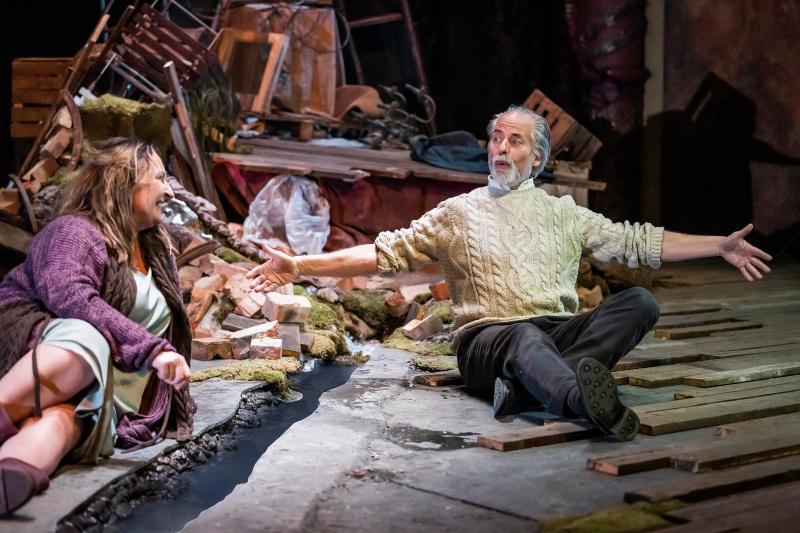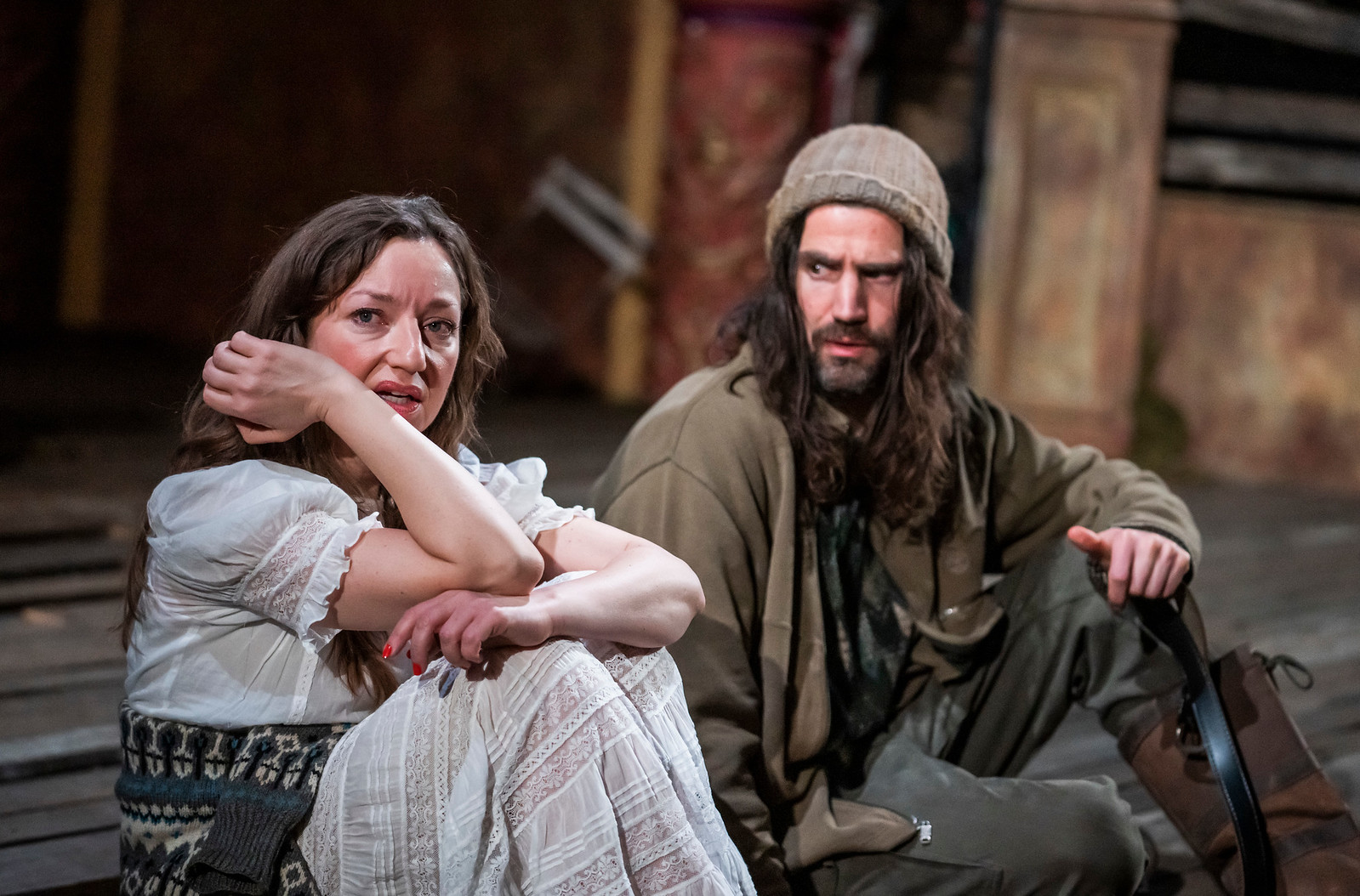When We Dead Awaken, The Norwegian Ibsen Company, Coronet Theatre review - living death, dying life | reviews, news & interviews
When We Dead Awaken, The Norwegian Ibsen Company, Coronet Theatre review - living death, dying life
When We Dead Awaken, The Norwegian Ibsen Company, Coronet Theatre review - living death, dying life
Ibsen anticipates Beckett in his strange final play, austerely staged with dashes of wit

In Ibsen's last and shortest play, further cut here, four people nominally climb a mountain, but actually seem to be crossing waste land towards the land of Samuel Beckett. It’s an amazing play in which reality is symbolic and symbols are real, where not one character is likeable and all speak with hallucinatory directness. The Norwegian Theatre Company, very much welcome back to the Coronet Theatre, do much of its strangeness justice.
Everyone who’s seen either the play or the film of Willy Russell’s Educating Rita will remember the protagonist’s response to the essay title “Suggest how you might resolve the staging difficulties inherent in a production of Ibsen’s Peer Gynt” - “Do it on the radio”. When We Dead Awaken is really a play for radio or film. Avoiding the kind of gimmicky attempt at an al fresco landscape which overwhelmed the Donmar drama of Swedes in the Alps Force Majeure, director Kjetil Bang Hansen and designer Mayou Trikerioti have jettisoned the settings of the three acts – outside a Norwegian spa hotel, a mountain health resort and the top of the mountain. They give us instead a house that looks as if it’s been bombed or long deserted, detritus piled up in a hill of sorts at the centre, a runnel heading downstage, vegetation growing in the cracks: the flotsam and jetsam of wasted lives. It’s a good use of the crumbling Coronet auditorium.  The four main characters adapt to the wildness, sitting on the broken planks and rarely on chairs, unwinding their bitterness, hatred and dim hope. Ibsen wastes no time in telling us who they are: egotistical sculptor Arnold Rubek (Oystein Roger), unfulfilled ever since he created what he seems to accept as a masterpiece; the artist’s model for that masterpiece Irene (Ragnhild Margrethe Gudbrandsen), jettisoned after what’s described by both, she bitterly, as an “episode” and since confined to a lunatic asylum, now followed about by a mostly silent carer; Rubek’s younger wife Maia (Andrea Bræin Hovig), longing for freedom; and the wild, satyr-like hunter Ulfhejm (Irish actor James Browne, pictured above with Hovig), who can partly satisfy that yearning.
The four main characters adapt to the wildness, sitting on the broken planks and rarely on chairs, unwinding their bitterness, hatred and dim hope. Ibsen wastes no time in telling us who they are: egotistical sculptor Arnold Rubek (Oystein Roger), unfulfilled ever since he created what he seems to accept as a masterpiece; the artist’s model for that masterpiece Irene (Ragnhild Margrethe Gudbrandsen), jettisoned after what’s described by both, she bitterly, as an “episode” and since confined to a lunatic asylum, now followed about by a mostly silent carer; Rubek’s younger wife Maia (Andrea Bræin Hovig), longing for freedom; and the wild, satyr-like hunter Ulfhejm (Irish actor James Browne, pictured above with Hovig), who can partly satisfy that yearning.
Ibsen translator and biographer Michael Meyer has written about “a certain kind of abstract high-flown writing which in any prose sounds grandiose, even windy”, adding that Ibsen intended to write his last play in verse – though of course he didn’t want to admit this would be the endgame. The actors’ triumph is to make it seem inevitable, however strange, and while Ibsen pricks the artistic grandiosity of his alter ego with the reactions of the women he’s used, this production goes still further in making it actually funny at times.
 That, at least, is the case when Irene asks about the fate of her “child”, Rubek’s marble masterpiece “The Day of Resurrection”. It’s been buried alive in the tomb of a distant museum, he tells her, and is forced to confess that her sculptured figure has been moved back on a bigger plinth to accommodate all sorts of humans with bestial essence beneath their human masks swarming out of a curved and fissured earth, putting himself at the front as a figure tormented by guilt.
That, at least, is the case when Irene asks about the fate of her “child”, Rubek’s marble masterpiece “The Day of Resurrection”. It’s been buried alive in the tomb of a distant museum, he tells her, and is forced to confess that her sculptured figure has been moved back on a bigger plinth to accommodate all sorts of humans with bestial essence beneath their human masks swarming out of a curved and fissured earth, putting himself at the front as a figure tormented by guilt.
There’s a weirder kind of playfulness between Maia and her hunter – edgy, dangerous, ultimately resolving to “stitch our tattered lives together”. They descend to the existence that the older couple sees as death, while Rubek and Irene ascend to the new life. It’s unstageable, and some of Ibsen’s directions are read out by the actors. Is that it, we ask? But the playwright himself left us with a sketch of a final act: the brevity of old age, like a Shakespeare late romance.
As with everything else in the play this denouement aspires to music, with its haunting refrains, its central quartet; someone should write an opera on it, but one that would have to be as lean, hungry and, fitfully, lyrical as the original drama. All credit to Bang-Hansen for keeping the peripheral sounds to a minimum, Meanwhile, there’s music in the actors’ delivery, switching from Norwegian to English for the scenes with the stranger-hunter, though the most striking sing-songiness comes in the original language from Gudbrandsen’s Irene (pictured above right). See it: I guarantee you won’t find the play better, or even as well, done by a British company.
The future of Arts Journalism
You can stop theartsdesk.com closing!
We urgently need financing to survive. Our fundraising drive has thus far raised £49,000 but we need to reach £100,000 or we will be forced to close. Please contribute here: https://gofund.me/c3f6033d
And if you can forward this information to anyone who might assist, we’d be grateful.

Subscribe to theartsdesk.com
Thank you for continuing to read our work on theartsdesk.com. For unlimited access to every article in its entirety, including our archive of more than 15,000 pieces, we're asking for £5 per month or £40 per year. We feel it's a very good deal, and hope you do too.
To take a subscription now simply click here.
And if you're looking for that extra gift for a friend or family member, why not treat them to a theartsdesk.com gift subscription?
more Theatre
 The Line of Beauty, Almeida Theatre review - the 80s revisited in theatrically ravishing form
Alan Hollinghurst novel is cunningly filleted, very finely acted
The Line of Beauty, Almeida Theatre review - the 80s revisited in theatrically ravishing form
Alan Hollinghurst novel is cunningly filleted, very finely acted
 Wendy & Peter Pan, Barbican Theatre review - mixed bag of panto and comic play, turned up to 11
The RSC adaptation is aimed at children, though all will thrill to its spectacle
Wendy & Peter Pan, Barbican Theatre review - mixed bag of panto and comic play, turned up to 11
The RSC adaptation is aimed at children, though all will thrill to its spectacle
 Hedda, Orange Tree Theatre review - a monument reimagined, perhaps even improved
Scandinavian masterpiece transplanted into a London reeling from the ravages of war
Hedda, Orange Tree Theatre review - a monument reimagined, perhaps even improved
Scandinavian masterpiece transplanted into a London reeling from the ravages of war
 The Assembled Parties, Hampstead review - a rarity, a well-made play delivered straight
Witty but poignant tribute to the strength of family ties as all around disintegrates
The Assembled Parties, Hampstead review - a rarity, a well-made play delivered straight
Witty but poignant tribute to the strength of family ties as all around disintegrates
 Mary Page Marlowe, Old Vic review - a starry portrait of a splintered life
Tracy Letts's Off Broadway play makes a shimmeringly powerful London debut
Mary Page Marlowe, Old Vic review - a starry portrait of a splintered life
Tracy Letts's Off Broadway play makes a shimmeringly powerful London debut
 Little Brother, Soho Theatre review - light, bright but emotionally true
This Verity Bargate Award-winning dramedy is entertaining as well as thought provoking
Little Brother, Soho Theatre review - light, bright but emotionally true
This Verity Bargate Award-winning dramedy is entertaining as well as thought provoking
 The Unbelievers, Royal Court Theatre - grimly compelling, powerfully performed
Nick Payne's new play is amongst his best
The Unbelievers, Royal Court Theatre - grimly compelling, powerfully performed
Nick Payne's new play is amongst his best
 The Maids, Donmar Warehouse review - vibrant cast lost in a spectacular-looking fever dream
Kip Williams revises Genet, with little gained in the update except eye-popping visuals
The Maids, Donmar Warehouse review - vibrant cast lost in a spectacular-looking fever dream
Kip Williams revises Genet, with little gained in the update except eye-popping visuals
 Ragdoll, Jermyn Street Theatre review - compelling and emotionally truthful
Katherine Moar returns with a Patty Hearst-inspired follow up to her debut hit 'Farm Hall'
Ragdoll, Jermyn Street Theatre review - compelling and emotionally truthful
Katherine Moar returns with a Patty Hearst-inspired follow up to her debut hit 'Farm Hall'
 Troilus and Cressida, Globe Theatre review - a 'problem play' with added problems
Raucous and carnivalesque, but also ugly and incomprehensible
Troilus and Cressida, Globe Theatre review - a 'problem play' with added problems
Raucous and carnivalesque, but also ugly and incomprehensible
 Clarkston, Trafalgar Theatre review - two lads on a road to nowhere
Netflix star, Joe Locke, is the selling point of a production that needs one
Clarkston, Trafalgar Theatre review - two lads on a road to nowhere
Netflix star, Joe Locke, is the selling point of a production that needs one
 Ghost Stories, Peacock Theatre review - spirited staging but short on scares
Impressive spectacle saves an ageing show in an unsuitable venue
Ghost Stories, Peacock Theatre review - spirited staging but short on scares
Impressive spectacle saves an ageing show in an unsuitable venue

Add comment